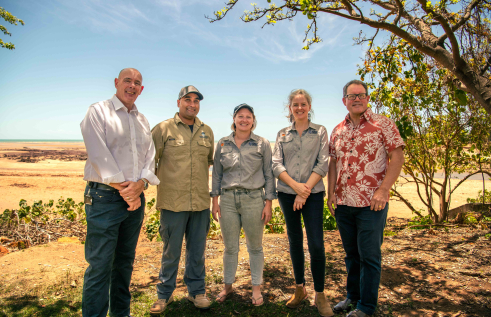Project to look at climate impacts on Northern Australia's turtle populations

A new project, between Charles Darwin University (CDU), Australian Institute of Marine Science (AIMS) and indigenous ranger groups, will investigate how sea level rise and increasing sand temperature may affect Northern Australia’s turtle populations.
According to researchers, climate change poses a significant threat to turtle populations in northern Australia with rising sea levels resulting in more and more turtle nests being drowned and an increase in sand temperature affecting hatching success and the gender of hatchlings.
CDU Senior Research Fellow and project lead, Dr Rachel Groom, said this project is collecting critical data to support the conservation of turtles that live and nest in northern Australia and to counter the threat.
“Turtles are threatened species that are vulnerable to many impacts,” Dr Groom said.
“Climate change is a process driving significant changes in nesting populations though we don’t have the data to quantify these impacts so this research will help answer questions that underpin the conservation of these animals.
“Through this project, we will work in partnership with Aboriginal communities across the Top End to better understand the current and projected impacts climate change is likely to have on these culturally important animals.”
The project involves researchers undertaking risk-based modelling of sea-level rise and temperature on NT nesting beaches. They will record the hatching success of three nesting stocks and conduct a range of fieldwork to characterise nesting habitats and record beach and in-nest temperatures.
“We will look at a range of things including sea level rise models, oceanographic data, predation pressure and information around sea surface temperature to help us determine which nesting areas are most vulnerable to impact,” she said.
Dr Vinay Udyawer from AIMS said climate driven factors affect marine turtle nesting populations differently, and in some cases, non-climate-related factors like nest predation could have a more pronounced impact.
“We’ll be conducting the project across key nesting locations in the NT with the aim to identify the specific processes most likely to influence each species and genetic stock,” Dr Udyawer said.
“This assessment will enable us to develop precise mitigation strategies tailored to the unique challenges faced by these populations.”
The researchers are also hopeful to learn more about hatchling sex ratios in the nests by collecting nest temperature data.
Temperature plays a key role in determining a turtle’s sex with researchers currently seeing an increasing trend of female hatchlings as hot temperatures produce females and cooler temperatures produce males.
“In far North Queensland we have seen the world’s largest green turtle rookery producing a 99 per cent female population due to a warming climate, it also has very poor hatching success,” Dr Groom said.
“At the moment we aren’t entirely sure what this higher ratio of female hatchlings will mean. There will be reduced genetic diversity which can lead to reduced fitness; likely, it’s another factor impacting these recovering populations, but we need more information on this.”
Data from this project will be presented by researchers at a knowledge sharing workshop with ranger group partners and Traditional Owners.
If the data shows some significant impacts from temperature, mitigation measures such as shading and cooling the nests will be discussed and co-designed to improve hatching success for Green, Hawksbill and Olive Ridley turtles.
“Local ranger knowledge is critical to this project as they are strong knowledge holders and many rangers, or their families have significant cultural responsibility and authority to look after turtles,” she said.
“Their involvement will strengthen decision-making and assist in on-ground recovery.”
Dr Udyawer added that “we will work with the rangers and provide training in collecting nest environment data and support them to implement appropriate mitigation measures beyond the life of this project.”
The study has been made possible by a partnership between CDU, AIMS and several Northern Territory ranger groups including the Anindilyakwa Rangers, Tiwi Island Marine Rangers, Crocodile Island Rangers, Bawinanga Rangers and Li-Anthawirriyarra Rangers.
The project has received a grant of $500,000 from the Australian Government as part of the Marine Turtle Climate Change Resilience and Nest Protection Program grant opportunity.
The Minister for the Environment and Water the Honorable Tanya Plibersek said the government wants to protect turtle populations from climate change.
“We want to protect our most vulnerable marine turtle populations from the impacts of climate change, and this project is just one way we’re working to achieve this,” Minister Plibersek said.
“This innovative project will support First Nations peoples, researchers and on-ground conservation activities to give our precious marine turtle populations the best chance of survival in the face of climate change.”
Member for Solomon Luke Gosling said the Australia Government’s investment is a welcome boost to the community.
“The $500,000 Australian Government investment is a welcome boost to the local community and our efforts to support local populations of marine turtles,” Mr Gosling said.
“I commend the work of Charles Darwin University and the Australian Institute of Marine Science for continuing to find innovative ways to tackle the impacts of climate change.
“Protecting our marine turtles and helping their populations thrive could boost tourism and lead to greater economic opportunities and jobs in local communities.”